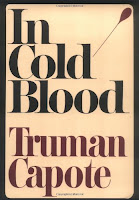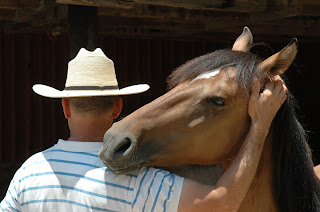More Book Posts from Facebook
Day 12/20 In Cold Blood Truman Capote 1965 (‘66)
I chose this book, in part, because it is so out of character for me. I hate “true crime” books, movies, and television shows. They seem voyeuristic, readers like ambulance chasers. But, as I said yesterday, I was in a book club about this time, and I probably ordered this book in 1966 or 1967.This might have been an early attempt at the new genre of creative nonfiction, although critics cite many parts of Capote’s book, about the 1959 brutal murder of a well-loved Kansas farmer, his wife, and two of their four children by two recently paroled ex-cons from the Kansas State Penitentiary, are fictionalized or simply not true. The ex-cons believe Herbert Clutter has a safe that contains a lot of money for his farming operation. They plan to steal the money and escape to Mexico where law enforcement can’t touch them. As it turns out, the Clutters had no safe, no substantial amounts of money, so the two hogtied and executed them.
Capote read about the case in The New York Times and eventually headed to Kansas to interview the people of the town and the two accused men. I learned several years after I read the book that Capote’s “research assistant” was his childhood friend, none other than Harper Lee (to make a good impression on the townsfolk), who had not yet written To Kill A Mockingbird. They say Capote accumulated 8,000 pages of notes and the book was published after the two men were executed. Capote said working on this book caused him to oppose the death penalty as there was some question about the means by which the court determined that the men were not temporarily insane at the time of the murders, which was their initial defense. Ultimately, the book is an excellent, if chilling, telling of horrendous crime – it is the second best selling true crime book to this day, after Helter Skelter by Vincent Bugliosi – but the reader must approach it with a great deal of skepticism.
It was made into a movie of the same name, starring Robert Blake (TV’s Baretta) as one of the murderers, to whom he bore an uncanny resemblance, and I admit that I saw it.
For a somewhat impressionable 15- to 16-year-old girl in small-town Iowa, where we never locked our doors and the phrase “stranger danger” hadn’t been invented yet, it was terrifying. It was a hardcover book, so I kept it, but I never read it again.
Day 13/20 On the Beach Nevil Shute 1957
I made a last-minute change to discuss this post-apocalyptic novel, perhaps because I’m feeling a bit gloomy after this week’s happenings. We’ll get to the other one in a day or so.I can’t imagine why I decided to read this book or when exactly I read it. I may have been available as part of my book club offerings, so that would mean I read it when I was about 16. I tend to gravitate toward post-apocalyptic settings because I’m just morose, I guess.
So, 16-year old, science fiction fan me read On the Beach, and I can’t say this about too many books, but this one changed me. This is a story about the aftermath of a nuclear war. Radiation has killed most of humankind and the only places left to live are parts of South Africa, parts of South America, New Zealand, and Australia. (Mind you, starting at about 10 or 11, I developed a fixation with Australia, so this might have been the motive behind my decision to read the book.) The radiation is moving south, however, and soon everyone will die from radiation poisoning. Life in Melbourne is relatively normal, but there is virtually no fuel, which makes travelling difficult. Everyone deals (or doesn’t deal) with the impending doom in different ways; the Australian government has issued suicide pills/injections for those who don’t want to die horribly from radiation poisoning. A mysterious radio signal is detected coming from Seattle, Washington, and one of the last American nuclear submarines goes to investigate, hoping to find someone alive. It’s all pretty depressing.
The title comes from T. S. Eliot’s poem, "The Hollow Men":
In this last of meeting places
We grope together
And avoid speech
Gathered on this beach of the tumid river.
This is the poem that ends
This is the way the world ends
Not with a bang but a whimper.
The novel does not accurately portray the course of fallout after multiple nuclear strikes. It does not include nuclear winter, and it doesn’t indicate that anyone survives – but in 1957, not much was known about what would happen to the planet and humanity in such a scenario. I read this book again in the 80s, and surprisingly (because I already knew the end and had even seen the 1959 movie (with Gregory Peck and Ave Gardner, probably on television), it still depressed me. There was also a three-hour mini-series that starred Armand Assante, Rachel Ward, and Bryan Brown (so at least this film had two Australians in it). All politicians and diplomats should read it. If you like this kind of plot, there’s William Brinkley’s The Last Ship (1988), which spawned a TNT TV series of the same name, loosely based on the novel, which aired from 2014 to 2018.




Comments